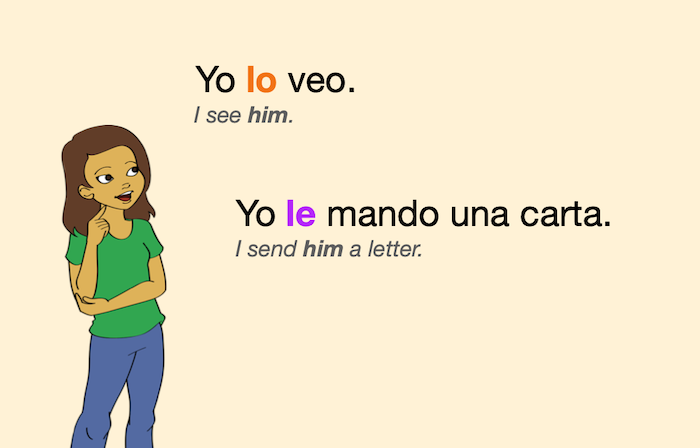
Welcome 😊 to our grammar lesson on Spanish object pronouns.
In this lesson we will talk about both direct and indirect object pronouns (“complemento directo” and “complemento indirecto”).

By the end, you will be able to identify Spanish object pronouns and use them correctly in sentences.
You will also find a Quiz and Exercises to practice.
For clarity, we will keep the color orange for direct and purple for indirect .
During this lesson, we are talking about the following 2 sets of pronouns:
| Spanish | English |
|---|---|
| me | me |
| te | you |
| lo, la | him, her (both can also mean "it" or formal "you") |
| nos | us |
| os | you guys |
| los, las | them (both can also mean formal plural "you") |
| Spanish | English |
|---|---|
| me | me |
| te | you |
| le | him, her, it, formal "you" |
| nos | us |
| os | you guys |
| les | them, formal plural "you" |
As we notice in the tables above, direct and indirect pronouns have almost identical forms. The only difference is in the third persons, where direct pronouns distinguish between genders ( lo-la , los-las ) and indirect pronouns don’t.
Direct object pronouns represent the person or thing directly receiving the action of the verb . For example, in the English sentence “Do you love me?”, “me” is a direct object pronoun.
¿Tú me quieres ?
Do you love me ?Sí, te quiero .
Yes, I love you .Laura nos conoce .
Laura knows us .Nosotros os vemos .
We see you guys .
The pronouns lo , la , los and las usually replace a noun. To choose between them, we need to consider the gender and number of that noun:
¿Conocéis a Miguel?
Do you guys know Miguel?
Sí, lo conocemos .
Yes, we know him . (“lo” represents “Miguel”, which is masculine singular)¿Tú tienes la revista?
Do you have the magazine?
Sí, yo la tengo en mi casa.
Yes, I have it in my house. (“la revista” is feminine singular)¿Has leído los libros?
Have you read the books?
No, no los he leído .
No, I haven’t read them . (“los libros” is masculine plural)¿Compra él las botellas?
Does he buy the bottles?
Sí, él las compra .
Yes, he buys them . (“las botellas” is feminine plural)
Indirect object pronouns represent the person or thing indirectly receiving the action of the verb . In other words, to whom or for whom the action is done. For example, in the sentence “I send her a letter”, “her” is an indirect object pronoun (not what I send, but to whom I send it).
¿ Me has mandado la carta?
Have you sent me the letter?Sí, te he mandado la carta.
Yes, I have sent you the letter.Yo le doy un beso.
I give her a kiss.Nuestra madre nos cuenta un cuento.
Our mother tells us a story.¿Qué os han dicho ?.
What have they told you guys ?Nosotros les llevamos bebidas.
We bring drinks to them .
In order to place object pronouns correctly in the sentence, we need to consider the tense of the verb they are connected with.
Depending of the tense, object pronouns can occupy two different spots:
Let’s study both possibilities:
This happens when the verb is conjugated in any tense with the exception of the Infinitive, Gerundio and Affirmative Commands.
Marta lo sabe .
Marta knows it . (present tense)Yo les he comprado un coche.
I have bought them a car. (present perfect)Ella nos llamó .
She called us . (preterite tense)No me insultes .
Don’t insult me . (negative command).Nosotros os contaremos un chiste.
We will tell you guys a joke. (future tense)Tú le mandarías una carta.
You would send him a letter. (conditional tense)
We attach object pronouns at the end of verbs in the Infinitive or Gerundio , and also of Affirmative Commands .
Mandar les la carta es importante.
Sending them the letter is important. (infinitive)Yo estoy comprándo los .
I’m buying them . (gerundio)Haz lo .
Do it . (affirmative command)
When we have 2 verbs combined
Some sentences have 2 verbs combined in the following way:
In this case, we have the freedom to place the pronouns either before the first verb (written separately), or attached at the end of the second verb :
Yo lo estoy haciendo .
Yo estoy haciéndo lo .
Both sentences mean “I’m doing it” .Os queremos dar un regalo.
Queremos dar os un regalo.
Both mean “We want to give you guys a present”.Tú la vas a comprar .
Tú vas a comprar la .
Both mean “You are going to buy it” .
There are sentences that include 2 object pronouns: one indirect and one direct.
When this happens, we place the pronouns in that order: first indirect , then direct .
The rest of the rules in this lesson still apply. We place the pronouns either before the verb (written separately) or attached at the end, depending on the tense as we have learned.
Yo te lo digo .
I say it to you . (present tense)Dí me lo
Say it to me . (affirmative command)
le and les become se when they are placed right before lo, la, los or las .
Yo se las he mandado .
I have sent them to him . (instead of“le las he mandado”)Juan quiere decír se lo .
Juan wants to say it to them . (instead of“decírleslo”)
Take this short Quiz about Object Pronouns: